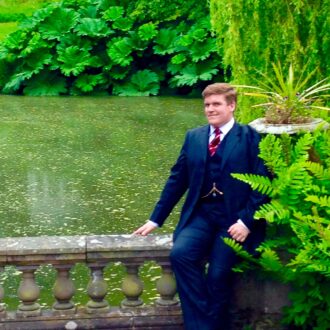Kyle Leyden’s research focuses on the contextualisation of buildings and urban topologies within the contemporaneous milieu of political activity, philosophical thought, artistic taste and foreign influence, and explores the ways in which this can transform orthodox historic narratives and challenge contemporary attitudes.
His work aims to apply the broadest range of cross-disciplinary and cross-methodological approaches to the study of the built environment in order to understand its meaning and message, in addition to its active agency – past and present – in political discourse and in constructing and sustaining narratives of place, identity and belonging. He is particularly concerned with the construction of national identities in the long eighteenth century, and exploring approaches and attitudes to the material legacies of empire in postcolonial societies. His work places emphasis on the way buildings were intended to be experienced as cultural objects by contemporary and later societies, stressing the theoretical importance of agency and lived experience.
Recent work on the agency of the built environment in the construction of Irish national identities in the early modern period has uncovered critical intersections between antiquarianism and the identity of the Irish landed elites which has continued resonances in contemporary discourse on Irish identity. This work has revealed how the complex web of semiotic indicators gained from the retention of the old negotiated and communicated an ideal of stable identity during periods when personal and national self-fashioning by the self or others was distinctly unstable. He is especially interested in exploring the appropriation of antiquities within built landscapes outside their archaeological or antiquarian context, and placing them instead into a semiotic relationship with later architectural developments.
Following a career at the Bar in the Irish and Northern Irish jurisdictions, Kyle joined the Courtauld in 2023 after completing and M.A. and doctorate in architectural history at the Institute. Past teaching experience has included roles within Trinity College, Dublin; the University of Notre Dame in England; and UCL. A current member of the Historic Buildings Council of Northern Ireland, he has worked for many years as a researcher and advisor to many of the major heritage bodies of the UK and Ireland, including carrying out in-depth research into the Somerset House site on behalf of the Courtauld Connects Project and Somerset House Trust. Most recently, he carried out research and editorial work on Mark Girouard’s Biographical Dictionary of English Architecture 1540-1640 on behalf of the Paul Mellon Centre, working closely with the author on his last major architectural work, and is currently in the process of completing work on Hamish Miles’ catalogue raisonné of the works of David Wilkie in conjunction with art historian Alex Kidson.
Teaching
- BA1: Architecture and Identity: London’s Public Architecture
- BA2: (Approaches) Monuments and Memory
- BA2: (Histories) Artists, Radicals and Mystics: European Art, 1760-1830
- MA: Circum-Atlantic Visual Culture, c.1770-1830
- MA: Architectural Legacies of Empire at Home and Abroad, c.1620-c.1920
Ph.D. Supervision
- Claire Ó Nualláin: ‘As our national character is now forming’: Antiquarianism, the Fine Arts and the Formation of Protestant Identity in Eighteenth-Century Ireland (AHRC-CHASE Funded)
Research interests
- Eighteenth-Century Architecture
- Eighteenth-Century Politics
- Ireland
- Country House Architecture
- Nationalism
- Post-Colonial Discourse
- Eighteenth-Century Decorative Studies
- The Enlightenment
Recent publications
- Co-Editor (with Alex Kidson), Hamish Miles, Catalogue Raisonné of the Paintings of Sir David Wilkie (New Haven and London; Yale University Press, Forthcoming)
- ‘Ireland at a Crossing: The Agency of St Patrick’s Cathedral, Armagh in Fashioning Irish Catholic Identity 1840-2003’, in Gómez, del Aura Elena, Hernanz and Yusta, Actas del Congreso Internacional VIII Centenario Catedral de Burgos: ‘El mundo de las catedrales’ (Burgos: Fundación VIII Centenario de la Catedral Burgos, 2022)
- Researcher and co-editor, Mark Girouard, A Biographical Dictionary of English Architecture 1540-1640 (London: Yale University Press, 2021)
- ‘A Room for Improvement: An Historic Perspective on the Great Room at Somerset House’, Courtauld News (2021).
- ‘”More Patrick’s house than any other”: Parliament House, Bank of Ireland and the Iconography of the Irish Patriotic Project 1728-1810”, Immediations 4.3 (2018)
- ‘Substance over style: Castletown and the protean politics of Irish “improvement”‘, Irish Architectural and Decorative Studies 20 (2018)
